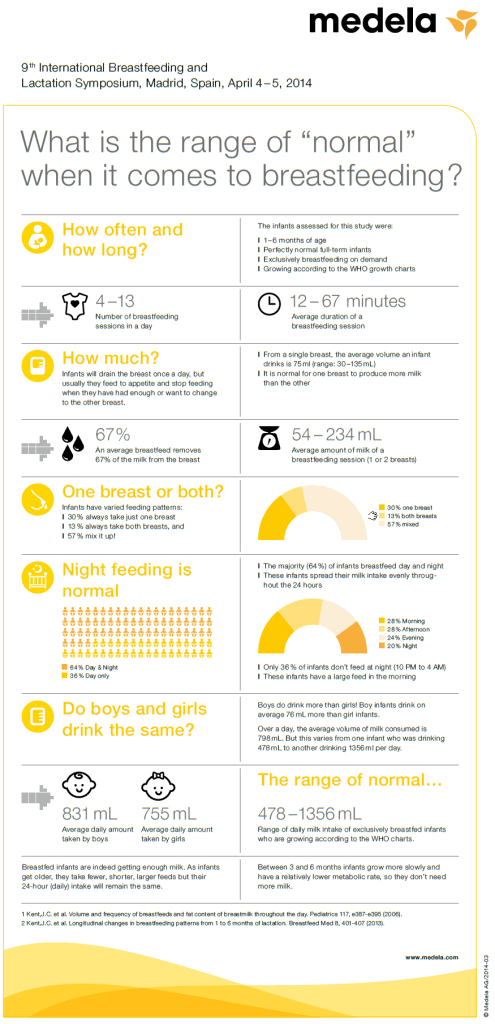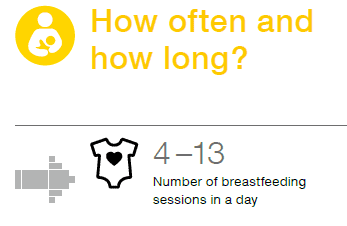When I breastfeed, how do I know I am doing it right? Is my baby getting enough milk? How often do I need to feed my baby? Why does my friend’s baby not feed as frequently? These are the types of questions regularly asked by mothers at some stage during their breastfeeding experience. Now, thanks to new studies1,2 from leading lactation researcher Jacqueline Kent the boundaries for ‘normal’ breastfeeding have been redefined and these common queries answered.
Research on breastfeeding
Kent’s recent analysis and explorations were presented for the first time at Medela’s 9th International Breastfeeding and Lactation Symposium in April. Her findings confirm that in fact there is no breastfeeding norm, no specific pattern that infants will, or need to adopt and certainly no set of rules that benchmark the right way to breastfeed. The new research explains that every breastfeeding relationship between mother and baby is unique and that it will adapt and change throughout the breastfeeding period. The differences may appear extreme, but are natural and not necessarily an indication of insufficient milk supply or other problems.
Kent’s conclusions will dramatically alter the way health professionals guide mothers in future and will provide a revised understanding for breastfeeding families. Better knowledge of the variability and expected changes in breastfeeding patterns will improve mothers’ confidence about their milk supply. Results show that:
- Breastfed infants control their milk intake to match their appetite and growth rate, taking what they need
- Exclusively breastfed infants normally show a wide variety of breastfeeding patterns
What the research found
Between one and six months of lactation, breastfed infants take fewer, faster, larger feeds, but their total daily milk intake is constant. Kent’s findings have highlighted the changes in breastfeeding patterns during a baby’s individual journey, sometimes changing monthly. But they also demonstrate that between infants, there is a wide variety of breastfeeding patterns and that they do not need to conform to an average. The significant variability in frequency and volume intake of the healthy, exclusively breastfed infant aged 1 to 6 months is as follows:
- 4-13 – the number of breastfeeding sessions per day
12-67 minutes – the duration of a breastfeeding session
- 54-234 ml – volume of milk consumed in a breastfeeding session
- 478-1356 ml – the volume of milk consumed in a 24 hour period
This knowledge will undoubtedly provide much-needed evidence to give health professionals confidence in various feeding situations and to give mothers self-assurance in their role. The breastfeeding community must take from this study the understanding that changes in an infant’s breastfeeding behaviours are completely normal, as are differences between babies. They are not an indication of insufficient milk supply. Lack of milk is often cited as one of the reasons mothers give up breastfeeding; the concern that their baby is not getting milk is naturally a worry. Mothers may think that because their baby is feeding more often it is a sign they are not getting enough each feed, but thanks to Kent we have learnt that this is not necessarily the case.
Using Kent’s new work to further educate both mothers and health professionals on the expected breastfeeding journey can potentially irradiate breastfeeding myths, thus making it a truly ground-breaking study in the field of lactation.

About Dr Jacqueline Kent:
Kent started her academic career with a Bachelor of Science at UWA. In 1986 she was appointed as a research assistant at UWA in the Hartmann Human Lactation Research Group. She completed her PhD in 1999 on the calcium in milk and is now working in the group as a Research Assistant Professor.
As part of the Hartmann Human Lactation Research Group, Jacqueline researches the biochemistry and physiology of lactation and breastfeeding in babies. The aim of the group is to understand exactly how the process of lactation works, in order to provide an evidence base to improve treatment when medical difficulties arise in breastfeeding mothers, and to encourage more mothers to breastfeed.
Jacqueline has published 36 papers in refereed journals, 7 review papers, and has been invited to present papers to breastfeeding counsellors, midwives and lactation consultants at local, national and international meetings. She is also mother of two breastfed daughters.
About Medela:
Founded in 1961 by Olle Larsson and headquartered in the Canton of Zug, Switzerland, Medela is owned by the Larsson-Rosenquist Family Foundation and continues to grow under the leadership of the Larsson family. Medela concentrates on two divisions: “Breastfeeding”, leading in the development and production of breastfeeding products, and “Healthcare”, engineering and manufacturing highly innovative medical vacuum technology solutions.
Medela conducts fundamental research together with leading scientists, medical professionals and universities, and uses the research results in the development of its products. Medela has 17 subsidiaries in Europe, North America and Asia, and together with independent partners distributes its products in more than 90 countries. The company employs around 1,500 staff worldwide, 330 of whom are located in the Canton of Zug. www.medela.com
References:
- Kent,J.C. et al. Volume and frequency of breastfeeds and fat content of breastmilk throughout the day. Pediatrics 117, e387-e395 (2006).
- Kent,J.C. et al. Longitudinal changes in breastfeeding patterns from 1 to 6 months of lactation. Breastfeeding Medicine 8, 401-407 (2013).


 12-67 minutes – the duration of a breastfeeding session
12-67 minutes – the duration of a breastfeeding session
I breastfed my first son for 22 months before he weaned himself, despite a very stressful start to our breastfeeding journey and being close to giving up many times in the early days.
My second son is 18 months old and still breastfed, I think he will continue to breastfeed for a long time to come, he feeds a lot more often than my first son did at this age!
It was important to breastfeed for me, particularly in the earliest days when I wanted them to get the colostrum. I sent myselves goals to get me through “I will do one more feed and see how I feel” changed to “I will feed until tomorrow and see how I feel” to “I will feed for this week and see how I feel” and that changed to “I will make it to the end of the month and see how I feel” and so forth, until I got to my goal of 12 months, and finally by then it all just felt easy and I was able to decide to wait until they weaned 🙂
It was very stressful for us, the pressure to be within ‘normal standards’ and the scientific studies seem to change depending on when and where it was done. In the end whatever our son wanted was all that mattered.
I breast fed my 3 kids and I am glad I did. I enjoyed it because I pounded with my kids.
I did Breast for 18 month, my daughter weened herself off.
All 3 I did breast first then bottle also and then eventually went bottle only. Had various issues with each child mainly supply issues and the usual.attachment problems.
I went bottle for my both my girls. I tried to breastfeed with my first but what I had wasn’t enough to keep her fed so I went to bottle and never looked back. After such a stressful first five days as a new mum I went straight to bottle for my second.
Mainly breastfed both kids with formula top ups if needed
Breastfed both ou boys. First til 10 months second til 17 months.
I breastfeed my baby for 10.5 months and she was healthy and chubby, and she still chubby and healthy even on formula.